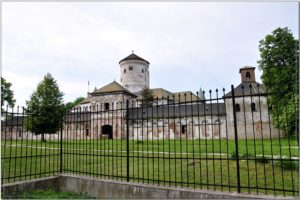Budatin

The castle of Budatin is located in the Upper lands/Horná Zem/Felvidék, in Slovakia, it is just one kilometer from Zsolna. The castle is about 250 meters away in a flat area, east of the confluence of the Vág and Kisucza rivers. (Please, note that I use the Oriental name order for Hungarian names where family names come first.)

It was built in the second part of the 13th century, most likely by Zólyomi Mikó and Detre or by their sons. They were the ancestors of the Hungarian Balassa family. The fort was built originally on the end of a ridge. Like all early castles, it was initially a stone tower. The center of the castle was this 11.5-meter-diameter, almost circular residential tower. The interior of the tower has a nearly square floor plan (6×6 meters). Until the early 1320s, this tower could only be surrounded by a plank wall (excavations revealed traces of a demolished earth-wood structure). The tower controlled an important road, near a ford, and also served as a tolling place.
Around 1300 it was occupied by the mighty oligarch, Csák Máté. After his death, the sons of Zólyomi Biter got the castle back from the king. In the second third of the 14th century, the castle tower was surrounded by a stone wall, and a palace building was erected on the ground floor in the northern part of the castle courtyard. Around the middle of the 15th century, this building was supplemented with additional residential wings in a northwest and west direction.

From 1323 we find it in the hands of King Károly Róbert; the fortress belonged to the Comes of Beszterce and remained a royal castle until 1438 when it came into the possession of the Hatnai family. Probably in the middle of the 15th century, a large outer castle was built to the north and the west. The floor plan of this outer castle is not known.


During the Dual Kingship, Podmaniczky János occupied the fortress in 1534, and King Habsburg Ferdinand awarded it to Szunyogh László in 1548. Then, it was owned by the Szunyogh family until 1798, although it was sometimes taken away from them for a longer or shorter period (e.g. by Prince Thököly’s army). Around the mid-16th century, the castle was rebuilt in the Renaissance style.
The Turkish threat from the south and more uprisings at the beginning of the 17th century forced the Szúnyogh family to fortify the castle in the Renaissance style. At that time, the Gothic castle was changed into a comfortable Renaissance palace. During the Baroque period in the 17th century, efforts were concentrated on building a chapel and finishing various outbuildings of the castle and surrounding it with the park. The outer castle, which has now been destroyed, was fortified with bastions in the west and north in the first half of the 17th century, but these disappeared in the 19th and 20th centuries.

The northwestern bastion of the outer castle was converted into a chapel in 1742, and then a two-story castle building was also erected in the southwestern part of the outer castle. The latter was badly damaged in 1849, and its partial renovation took place only after 1870. During later reconstructions, around the beginning of the 20th century, the palace was demolished.

In 1798, the Szunyogh family became extinct, and Csáky Antal received Budatin with the hand of Szunyogh Jozefina. Csáky László, the chief comes of Szepes County, took part in the Hungarian War of Independence in 1848/49. Nearby, there was a famous victory of the Hungarian army, they defeated the Imperial troops of General Hurban at the Jablonka Pass of the Carpathian Mountains. It was the reason why the Imperial army, supported by Slovak insurgents, set fire to the castle out of revenge. Its famous library was burned down by General Götz.

The building complex remained dilapidated until 1870 when it was partially renovated and housed a military wing. In 1918, the Counts of Csáky regained Budatin and owned it until 1944. The present condition of the castle dates back to the reconstructions carried out in 1920–1923. In place of the eastern part of the palace, connected to the south-western side of the castle, a historicist-style building with a corner tower was built.

Budatin soon became the property of the Czechoslovak state. It was restored in the 1950s and has belonged to the Považské Museum since 1956. Since 2006, the castle has not been open to the public.
In 2006-2007, before the commencement of the planned general restoration work, an archaeological excavation was carried out in the area of the castle. In 2013, the residential tower and roof were renovated.

Dear Readers, I can only make this content available through small donations or by selling my books or T-shirts:
Please, feel free to support me with a coffee here:
You can check out my books "33 Castles, Battles, Legends" and "The Ring of Kékkő Castle" on Amazon or Draft2Digital, they are available in hardcover, paperback, or ebook: https://www.amazon.com/dp/198020490X or at https://books2read.com/b/boYd81
 My work can also be followed and supported on Patreon: Become a Patron!http://Become a Patron!
My work can also be followed and supported on Patreon: Become a Patron!http://Become a Patron!


https://hungarianottomanwars.myspreadshop.com/all
































